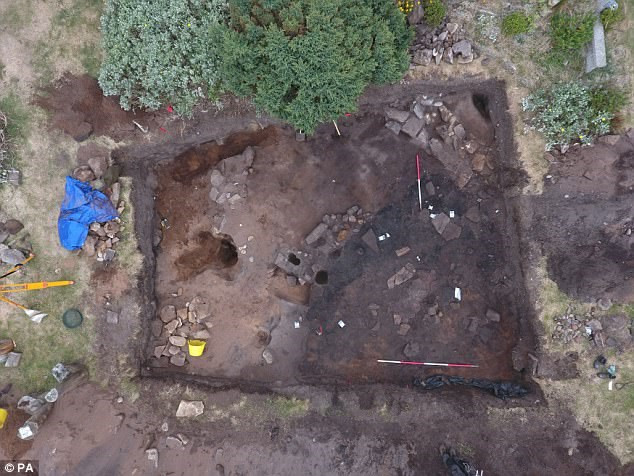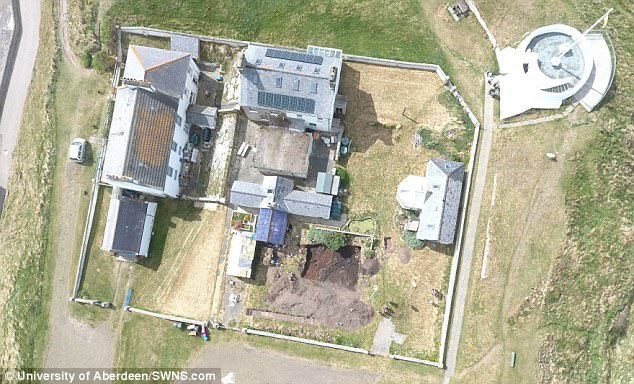Found 1,100-year-old Anglo Saxon coins and long Pict houses
Archaeologists have found a long house and a 1,100-year-old coin of the Anglo Saxon while excavating at Fort Burghead, near Lossiemouth, Moray, Scotland.
Experts believe that the fort once served as an important ruler in the Pict's kingdom - often described as the forgotten ancient Scottish race, dating from 500 to 1,000 years later. AD

Photograph of the archaeological area.(Source: dailymail.co.uk).
Artifacts include cow-shaped carvings in Burghead and a mysterious underground well mouth discovered in the 1800s, while other artifacts are thought to have been destroyed when a new town was built on the side. on the fortress also during that time.
However, a new excavation by researchers from Aberdeen University has led to new findings.
The excavation team discovered a long house of Pict people, and found an Anglo Saxon coin of Alfred the Great in it, thereby providing key dating evidence for the use of the house. and the former fortress.

Archaeologists have begun to find very significant remnants of the Pict people.(Source: dailymail.co.uk)
Archaeologists say the coins date from the late 9th century, when the robberies and settlements of the Vikings led to major changes in Pict society.
Dr Gordon Noble, a senior lecturer at the University of Aberdeen, said: 'The assumption is always nothing left in Burghead; that they all turned to ash in the 19th century but no one really looked carefully inside the fort to check if there was anything else left. "
'Under the stone bricks of the 19th century, we began to find very significant remnants of the Pict people. We probably discovered a long house of Pict people. This is important because Burghead is likely to be one of the key royal centers in North Pictland, and understanding the nature of fortress settlement is critical to understanding the power How is materialized in these important protected areas, " Gordon Noble said.

Anglo saxon coin.(Source: dailymail.co.uk).
'There is a beautiful stone fireplace at one end of the building and the Anglo Saxon coin shows that this building dates back to the end of the fortress time, based on previous dating results. " Dr. Noble said. 'The coin is also an interesting finding, because it shows that people living in the fort have been able to access large-scale exchange networks. the hole, probably worn on it, shows that people living in the fortress in this non-monetary economy have exhibited wealth right on their bodies. "
Dr Gordon Noble said: 'In general, these findings suggest that it is still possible to gather a lot of valuable information from Burghead to tell us more about this society in a very significant time. meaning for Northern Scotland - as soon as the migrant Vikings are strengthening their power in Shetland and Orkney, and conducting attacks on the Scottish continent. "

Burghead Fortress has long been recognized as a place of important rule in early medieval times.(Source: dailymail.co.uk).
Excavations were conducted with the Burghead Headland organization and the Archaeological section of the Aberdeenshire Council.
Archaeologist of the Aberdeenshire Council Bruce Mann said: 'Burghead Fortress has long been recognized as a place of important rule in the early middle ages and is known as the largest fortress of its kind Scotland. Its importance has continued to increase with this finding. It is amazing that we have buildings and foundations dating back to this age, and the work the university is doing is revealing more about what is often called the wrong time: "the time dark period "".
- Anglo-Saxon women are buried with luxury jewelry
- Poor falling into the sky suddenly changed into a millionaire by finding out this one no one uses
- Discover the biggest treasure in the UK
- Burial practice reveals Anglo-Saxon beliefs
- Test AND and the secret of Viking empire
- Alfred Dai's remains
- You: Discover new treasure from the Anglo-Saxon era
- He discovered an ancient tomb that was strangely buried
- 1,400 year old cemetery discovered on the Scottish plateau
- Found 30,000 silver Roman coins
- Two girls find a 1200-year-old coin
- The most exotic coins in the world
 Discovered an ancient centipede fossil 99 million years old
Discovered an ancient centipede fossil 99 million years old Discovered bat-like dinosaurs in China
Discovered bat-like dinosaurs in China Discovered a 200-year-old bronze cannon of the coast
Discovered a 200-year-old bronze cannon of the coast Discover 305 million-year-old spider fossils
Discover 305 million-year-old spider fossils